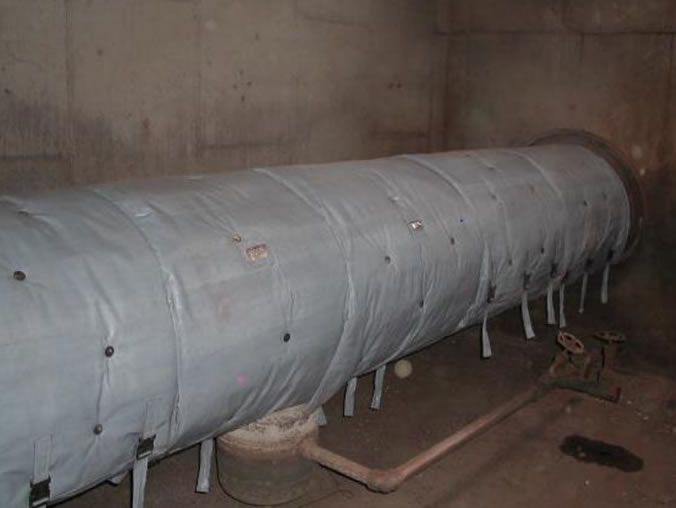CORROSIVE STEAM PROCESS ENHANCED DESIGN
LT550LFP-M (LT288C-LFP-M)
INTRODUCTION
Shannon Thermal Blankets are a CAD designed /CNC produced, high quality pre-engineered insulation system designed to save energy, retain radiant heat, minimize insulation maintenance and improve the surrounding work environment. Shannon Thermal Blankets are weather and chemical resistant. Shannon Thermal Blankets are flexible and easy to install, remove and reinstall allowing quick access and easy equipment serviceability. The key benefit is re-usability.
Common Applications and Markets:
Shannon Thermal Blanket Applications include: Valves, Flanges, Pumps, Expansion Joints, Drip Legs, Piping, Equipment and Complex Surfaces that otherwise are left untreated. Confined Space applications with high temperature, steam vapor & flooding.
Service Temperature
Steam & Hot Water Systems subjected to Carbonic Acid Non-Vented Atmospheres. This design is to act as a Thermal Barrier with a maximum service temperature of 288˚C (550˚F).
Product Components
The Outer and Inner Non-Porous Jacketing is a 459 g/m² (13.5 oz/yd²) 100 percent PTFE Laminate. The Insulation Core Material is a 1/8”-1/2” thickness (3.18mm-12.8mm) Non-Woven Glass Fiber – Lydall Manniglas® 1900 @ 7.5 pcf, (0.12 g/cc). The insulation material is encapsulated by the PTFE jacketing and sewn together, producing a “Self-Contained Blanket System”, highly corrosive resistant. The Shannon Blanket System includes Integral Fasteners for install & removal.

24” Piping / Expansion Joint
District Heating – Manhole (Confined Space)
BLANKET THICKNESS SURFACE TEMPERATURE REFERENCE
Operating Temp |
Thickness |
Surface Temp |
Thickness |
Surface Temp |
Thickness |
Surface Temp |
|---|---|---|---|---|---|---|
| 121˚ C (250˚ F) | 25 mm( 1″) | 37.9˚ C (100.2˚ F) | 40 mm( 1.5″) | 33.3˚ C (92.0˚ F) | 50 mm (2″) | 30.8˚ C (87.4˚ F) |
| 149˚ C (300˚ F) | 25 mm( 1″) | 42.6˚ C (108.6˚ F) | 40 mm( 1.5″) | 36.8˚ C (98.2˚ F) | 50 mm (2″) | 33.5˚ C (92.3˚ F) |
| 177˚ C (350˚ F) | 25 mm( 1″) | 47.3 ˚C (117.2˚ F) | 40 mm( 1.5″) | 40.3˚ C (104.6˚ F) | 50 mm (2″) | 36.3˚ C (97.4˚ F) |
| 204˚ C (400˚ F) | 25 mm( 1″) | 52.2˚ C (126.0˚ F) | 40 mm( 1.5″) | 44.0 ˚C (111.2˚ F) | 50 mm (2″) | 39.3 ˚C (102.7˚ F) |
| 232˚ C (450˚ F) | 25 mm( 1″) | 57.2˚ C (135.1˚ F) | 40 mm( 1.5″) | 47.8 ˚C (118.0˚ F) | 50 mm (2″) | 42.3 ˚C (108.2˚ F) |
| 260˚ C (500˚ F) | 25 mm( 1″) | 62.5˚ C (144.5˚ F) | 40 mm( 1.5″) | 51.7 ˚C (125.1˚ F) | 50 mm (2″) | 45.5 ˚C (113.9˚ F) |
| 287.8˚ C (550˚ F) | 25 mm( 1″) | 67.9˚ C (154.2˚ F) | 40 mm( 1.5″) | 55.8 ˚C (132.4˚ F) | 50 mm (2″) | 48.9 ˚C (119.9˚ F) |
* The above referenced Cold Face Surface Temperatures should be used as guidelines for blanket insulation thickness design.
* The Cold Face Surface Temperature of the blanket should approach surrounding ambient temperature conditions.
* The economic thickness of the blanket should consider blanket cost, thermal performance and blanket design constraints.
* Heat loss calculations are based on a 21.1˚ C (70˚ F) ambient temperature using a flat surface condition.
